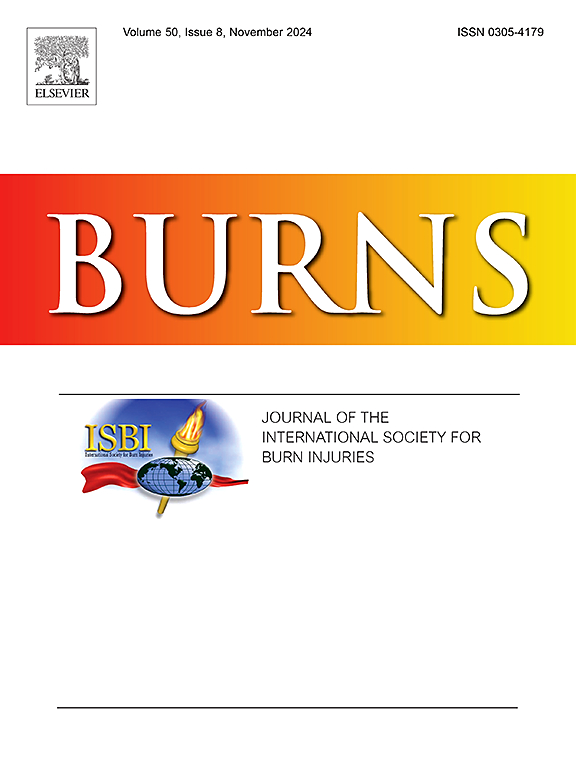Implementation of a multimodal pain protocol in adult burn patients
IF 3.2
3区 医学
Q2 CRITICAL CARE MEDICINE
引用次数: 0
Abstract
The 2020 American Burn Association guidelines recommend a multimodal approach to pain management comprised of both opioids and non-opioids. The purpose of this study was to compare outcomes before and after implementation of a multimodal pain order set in the burn admission order set within the electronic medical record. This single center, retrospective, cohort study was conducted at an American Burn Association-verified burn center. The pre-group (n = 64) and post-group (n = 63) were well-matched with respect to all baseline demographics, such as total body surface area, length of stay, mechanical ventilation, and number of procedures. The primary outcome was daily morphine milligram equivalents received cumulatively through admission day seven. There was a significant reduction in cumulative median morphine milligram equivalents received in the post-group compared to the pre-group (172 versus 97, p = 0.042) without worsening evidence of pain. Doses of scheduled acetaminophen (62.5 % versus 95.2 %, p < 0.001), ibuprofen (31.3 % versus 42.9 %, p = 0.017), and ketamine (14.1 % versus 28.6 %, p = 0.043) were significantly increased in the post-group. Multimodal order set integration significantly improved guideline recommended multimodal analgesic use and is one effective method to increase non-opioid analgesic use for acute pain following a burn injury.
成人烧伤患者多模式疼痛治疗方案的实施
2020年美国烧伤协会指南建议采用由阿片类药物和非阿片类药物组成的多模式疼痛管理方法。本研究的目的是比较电子病历中烧伤入院医嘱中设置的多模态疼痛顺序实施前后的结果。这项单中心、回顾性、队列研究在美国烧伤协会认证的烧伤中心进行。前组(n = 64)和后组(n = 63)在所有基线人口统计数据(如体表总面积、住院时间、机械通气和手术次数)方面匹配良好。主要结果是入院第7天累积每日吗啡毫克当量。与治疗前相比,治疗后组接受的累积中位数吗啡毫克当量显著减少(172对97,p = 0.042),没有疼痛恶化的迹象。预定的对乙酰氨基酚的剂量(62.5 %和95.2 % p & lt; 0.001)、布洛芬(31.3 %和42.9 % p = 0.017),和氯胺酮(14.1 %和28.6 % p = 0.043)在post-group显著增加。多模式序集整合显著改善了指南推荐的多模式镇痛使用,是增加烧伤后急性疼痛非阿片类镇痛使用的一种有效方法。
本文章由计算机程序翻译,如有差异,请以英文原文为准。
求助全文
约1分钟内获得全文
求助全文
来源期刊

Burns
医学-皮肤病学
CiteScore
4.50
自引率
18.50%
发文量
304
审稿时长
72 days
期刊介绍:
Burns aims to foster the exchange of information among all engaged in preventing and treating the effects of burns. The journal focuses on clinical, scientific and social aspects of these injuries and covers the prevention of the injury, the epidemiology of such injuries and all aspects of treatment including development of new techniques and technologies and verification of existing ones. Regular features include clinical and scientific papers, state of the art reviews and descriptions of burn-care in practice.
Topics covered by Burns include: the effects of smoke on man and animals, their tissues and cells; the responses to and treatment of patients and animals with chemical injuries to the skin; the biological and clinical effects of cold injuries; surgical techniques which are, or may be relevant to the treatment of burned patients during the acute or reconstructive phase following injury; well controlled laboratory studies of the effectiveness of anti-microbial agents on infection and new materials on scarring and healing; inflammatory responses to injury, effectiveness of related agents and other compounds used to modify the physiological and cellular responses to the injury; experimental studies of burns and the outcome of burn wound healing; regenerative medicine concerning the skin.
 求助内容:
求助内容: 应助结果提醒方式:
应助结果提醒方式:


